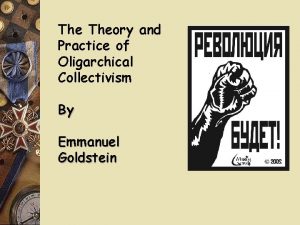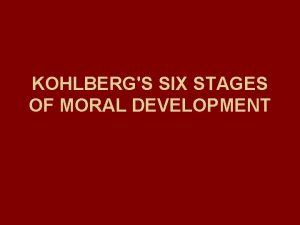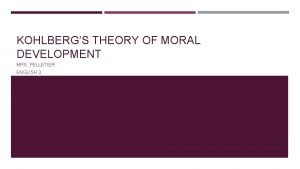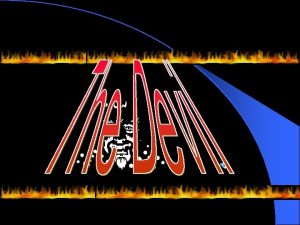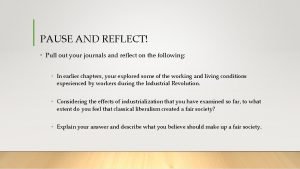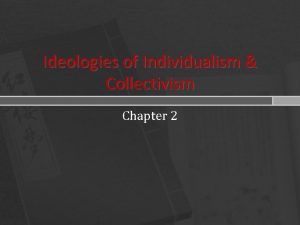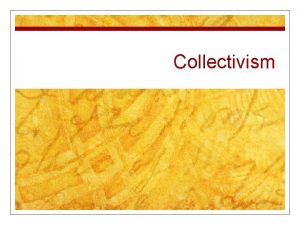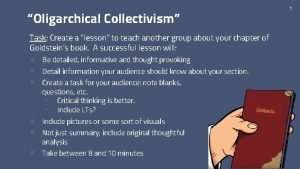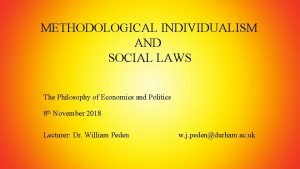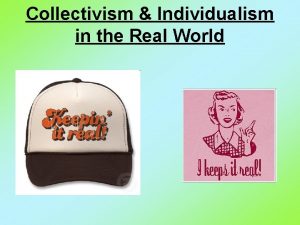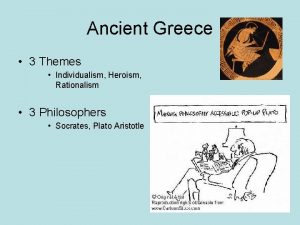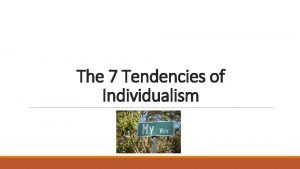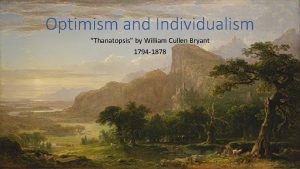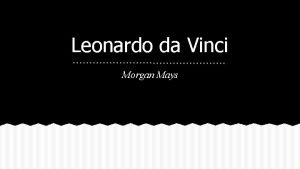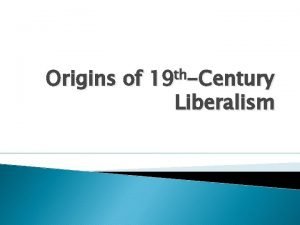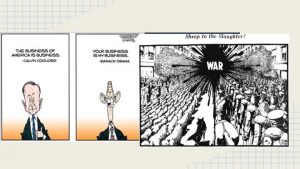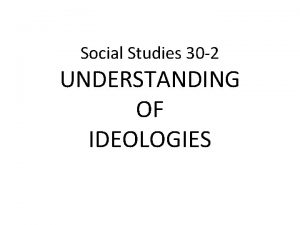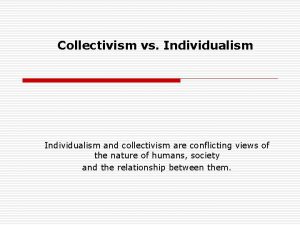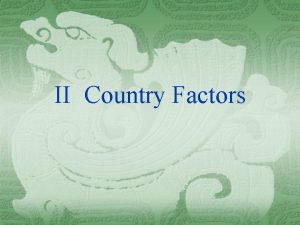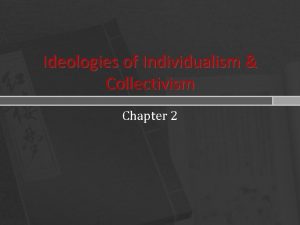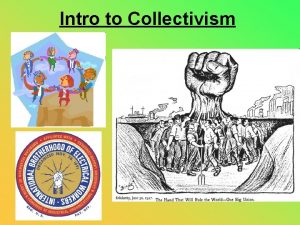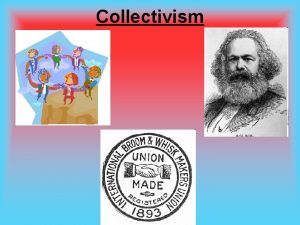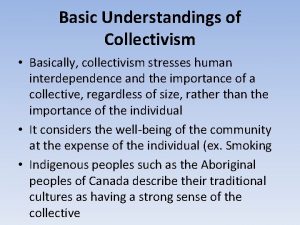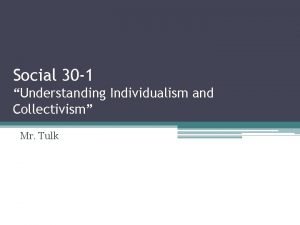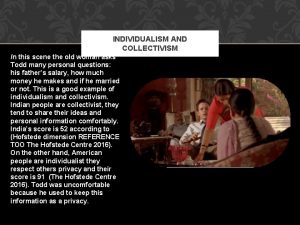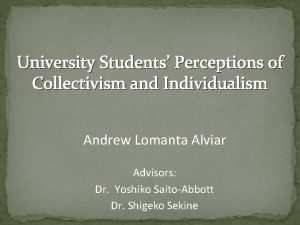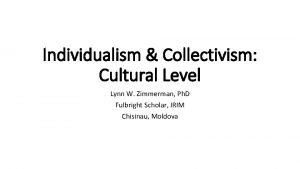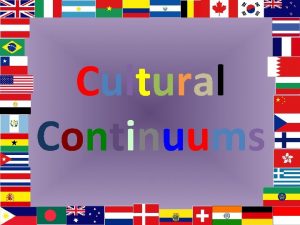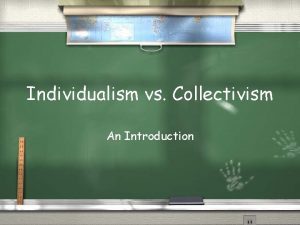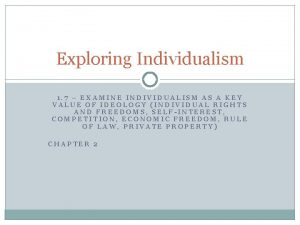Chapter 2 Ideologies of Individualism and Collectivism Ideologies






































- Slides: 38

Chapter # 2 Ideologies of Individualism and Collectivism

Ideologies are sometimes based on the philosophy and thought of groups of thinkers (schools of thought) Liberal Thought Dead Liberal Philosophers l l l Thomas Hobbes (1588 – 1679) John Locke (1632 – 1704) Jean – Jacques Rousseau (1712 -1778) Adam Smith (1723 -90) Socialism John Stuart Mill (1806 – 73) Karl Marx (1818 -83) 2020 -10 -07 2

Chapter 2 Ideologies of Individualism and Collectivism Vocabulary Assignment

(review from assignment) Individualism l l Individual rights and freedoms from government control Self-interest, personal achievement and self reliance Collectivism l l l Collectivist endorse the idea of working cooperatively to solve social issues Collective enterprises, unions and teamwork Government assistance and control in regards to the economy

Bumper stickers

Bumper Stickers p. 62 l Read each bumper sticker and decide whether it is for individualism or collectivism

Principles of Individualism are the foundation of Liberalism Rule of Law: l Every individual is equal before the law. l If anyone were above the law, none of our liberties would be safe. l Are there instances in our society where the rule of law seems be ignored? (review from assignment)

Individual Rights and Freedoms l l Key principle of individualism and an important feature of liberal democracies. Example • The right to vote: not all early liberal democracies extended this right in the same way. (review from assignment)

England The charter had six points: 1. a vote for all men; 2. voting to be secret so that workers would not be afraid of offending their landlord or boss by the way they voted; 3. any man could stand for parliament 4. members of parliament to be paid (necessary if workers were to get into parliament); 5. electorates to have the same number of voters; 6. parliament to be elected every year. Woman received the right to vote in 1919 after WW I ( had to be over 30 yrs.

Those that promoted the rights of woman were called Suffragettes

France Tennis Court Oath in 1789 Declaration of the rights of man http: //www. youtube. com/watch? v=g. AYJNTZk 4 Hw

France l l 1789 all men receive the right to vote Woman were granted the right to vote in 1944 ( after France was liberated in WW II)

Declaration of Independence https: //www. youtube. com/watch? v=yb 7 MI 8 NQLoo Kennedy’s perspective on the Declaration of Independence https: //www. youtube. com/w atch? v=6 PSUr 9 r. MVtc

United States l l Declaration of Independence In the early years some states in the USA voters had to be male and Protestant By the time of the Civil War 1860 most white men were allowed to vote, whether or not they owned property, . Literacy tests, poll taxes, and even religious tests were used in various places, and most white women, people of color, and Native Americans still could not vote.

Men in the USA were opposed to woman suffrage. Women received the right to vote in 1920

Women suffrage Canada The first women to be given the vote in federal elections were nurses serving in World War One. l Manitoba 1916 Alberta and Saskatchewan followed later in 1916, British Columbia in 1917, Ontario in 1917 (women could not hold office until 1919), Nova Scotia in 1918, Yukon in 1919 New Brunswick in 1918 (women could not hold office until 1934), Prince Edward Island in 1922, Newfoundland in 1925 and Quebec in 1940. NWT in 1951 Charter of rights and freedoms l http: //www. youtube. com/watch? v=5 a 1 pv_XKCyk l l l

CANADA l 1960 Passage of a new Canada Elections Act removed the disqualification from voting for registered Indians living on reserves. This was partly the result of recognition that many Aboriginal people had served with distinction in the Canadian Forces during the Second World War.

CANADA l 2004 : all prisoners in Canadian prisons become eligible to vote in Federal elections

A balance between individual rights and the rights of groups and society.

South Africa and Apartheid l A legally and physically enforced system of racial segregation and discrimination against blacks and others of coloured descent in South Africa which existed until 1994

Charter of Rights and Freedom (review from assignment) l l Guarantees are subject to “ such reasonable limits prescribed by law” Laws that prohibit the promotion of hatred or discrimination.

The Keegstra Case l l Keegstra was a high school teacher in the small Alberta town of Eckville. In 1984, he was charged with unlawfully promoting hatred against an identifiable group under s. 319(2) of the Criminal Code. The charges stemmed from Keegstra's anti-Semitic (anti-Jewish) statements to his students. He had described Jews as "revolutionists, " "treacherous, " "impostors, " "communists, " "secret, " " sneaky, " " manipulative, " and " deceptive. " He taught that Jewish people were "barbaric, " "subversive, " "sadistic, " " materialistic, " " money-loving, " and " power hungry. " He advised the students that they were to accept his views as true unless they were able to contradict them. Students who echoed his views generally received better grades than those who didn't. Under the Criminal Code, Keegstra could have made such statements legally if certain conditions applied , but none of them did. He made the statements in public, in his capacity as a teacher. He made them solely to attack Jewish peoples and not in any effort to generate discussion for public benefit.

The Keegstra Case l l How did Keegstra defend his actions? He argued that s. 319(2) of the Criminal Code violated his right to freedom of expression guaranteed under the Canadian Charter of Rights and Freedoms. . The Court unanimously (4 -3 margin) concluded that hate propaganda formed part of protected freedom of expression of the Canadian Charter of Rights and Freedoms because hate propaganda is a form of expression. l “If the guarantee of freedom of expression is to have meaning, it must protect expression which disputes even the basic idea of our society. A real commitment to respect for freedom of expression demands nothing less. "

Private Property l How have First Nations people viewed the idea of Private Property? l Give example where the protection of private property can also be a source of conflict. (review from assignment)

Economic Freedom l l Adam Smith: philosopher who believed that government should leave the economy alone to fend for itself. • Free market, and the welfare state. Do you support economic freedom? For what reasons?

Self-Interest & Competition Supply l l The supply curve is the relationship between “ market price” and the amount producers are willing to supply. The lower the “ market price” the less the farmer will put on the market. Demand l l l the quality of a good that consumers will buy at any one time depends on the price. Increases when economy is strong. A shortage is feared --people stock up https: //www. youtube. com/watch? v=4 ERb. C 7 Jy. Cf. U

Supply and Demand (review from class discussion) l l Demand: the quality of a good that consumers will buy at any one time depends on the price. The higher the price, the less quantity people are willing to buy. The lower the “market price” the more units will be demanded. The relationship between price and quantity bought is called the demand schedule or demand curve. http: //www. youtube. com/watch? v=R 5 Gppi. O 3 a 8

Demand l l (review from class discussion) Tends to increase when: consumers have more money the price of the goods fall a shortage is feared --- people stock up (review from class discussion)

SUPPLY (review from class discussion) The supply curve is the relationship between “ market price” and the amount producers are willing to supply. l The lower the “ market price” the less the farmer will put on the market. l

Supply l l (review from class discussion) Supply tends to increase when: demand is up prices rise more producers offer the goods for sale

Principles of Collectivism IMPT. CONEPTS What are the characteristics of a system that promotes Economic equality? l l Review your vocabulary sheet. How have Aboriginal peoples approached decisions from a collective base? **

Public Property/Collective Interests 82 -83 • Define the term Public Property and contrast the following case studies. l Karl Marx l Liberal democracies

Collective Responsibility? Collective Norms P. 84 -86 l l Do you support collective responsibility that asserts that there is no individual action for which the group cannot in some way be held accountable? Would you want to live in a society in which membership depended on adherence to particular standards? Why or why not?

Concept Review l l l P rivate property R ule of law: I ndividual rights and freedoms C ompetition E conomic freedom S elf-interest l l l l Collectivism Economic equality Co-operation Public property Collective interests Collective responsibility Collective norms

Contemporary Individualism and Collectivism l l l Pause and Reflect p. 87 In what ways do you think Jeff Skoll is an example of individualism? In what ways do his actions demonstrate collectivism? What are some of the attitudes and examples about individualism and collectivism in North America and Europe? p. 88 -91 Read and make notes.

Social Programs and Public Service NOTES

Child Care and Ideology l l Something to think about: To what extent is child care the responsibility of the government? P. 92 -93 How do various forms of child-care provision and funding reflect specific principles of individualism or collectivism?

Where Collectivism and Individualism meet p. 96 read l Principles of Individualism l Principles of Collectivism
 Oligarchical collectivism meaning
Oligarchical collectivism meaning Oligarchical collectivism
Oligarchical collectivism Kohlberg's six stages
Kohlberg's six stages Stage 2 individualism and exchange
Stage 2 individualism and exchange Individualism and momentum around the world
Individualism and momentum around the world Individualism in the devil and tom walker
Individualism in the devil and tom walker Who are these
Who are these Individualistic culture vs. collectivist culture
Individualistic culture vs. collectivist culture Principles of individualism
Principles of individualism Examples of individualism
Examples of individualism Economic equality
Economic equality Oligarchical collectivism
Oligarchical collectivism Collectivism government
Collectivism government Oligarchical collectivism definition
Oligarchical collectivism definition Political ideology ap government
Political ideology ap government Transcendentalism individualism
Transcendentalism individualism Methodological individualism weber
Methodological individualism weber Examples of individualism
Examples of individualism Individualism in ancient greece
Individualism in ancient greece 7 tendencies of individualism
7 tendencies of individualism Individualism in thanatopsis
Individualism in thanatopsis The dark side of individualism
The dark side of individualism Mona lisa individualism
Mona lisa individualism Individualism romanticism
Individualism romanticism Individualism
Individualism Monologue themes
Monologue themes Isolationsim
Isolationsim Democratic socialism
Democratic socialism Discourse ideology
Discourse ideology Social 30-2 module answers
Social 30-2 module answers Two dimensions of political ideologies
Two dimensions of political ideologies Obsolescent “frontier” civilization
Obsolescent “frontier” civilization Introduction to the curriculum ideologies
Introduction to the curriculum ideologies An age of ideologies
An age of ideologies Elizabethan ideologies
Elizabethan ideologies Political ideologies cows
Political ideologies cows Marxism principles
Marxism principles Types of ideologies
Types of ideologies An age of ideologies
An age of ideologies
